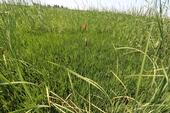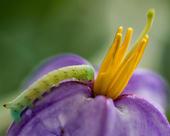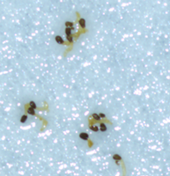- Author: Deniz Inci
- Author: Kassim Al-Khatib
- Posted by: Samson Romano

Loyant® CA Section 2(ee) Recommendation Bulletin for Control of Cattail in Rice
A recommendation bulletin has been released for florpyrauxifen-benzyl (Loyant® CA, Corteva Agriscience LLC, Indianapolis, IN, USA) to control cattail plants in California rice fields and permitted under FIFRA Section 2(ee). Cattail (Typha latifolia L.) also known as common cattail or broadleaf cattail is a perennial wetland weed that naturally occurs widely in nearly all North America and are often considered undesirable, weedy, or invasive. Common cattail is cosmopolitan weed that can grow up to 10-ft tall under favorable conditions. Common cattail has recently been more problematic in the drill-seeded rice...
- Author: John Lovett
- Posted by: Gale Perez

Pair of studies offers evidence into "superweed's" defensive tactics, strategy
FAYETTEVILLE, Ark. — A study of the effects of mowing on a common weed has found that what doesn't kill you can make you stronger.
A study published in Nature's Scientific Reports has found that frequent mowing of Solanum elaeagnifolium may help create a “superweed.”
Solanum elaeagnifolium — also known as silverleaf nightshade — can be found from south Texas to South Africa and Greece, infesting fields and soaking up valuable nutrients intended for cash crops. The weed with purple flowers – sometimes white and light purple – has prickly...
- Author: Drew Lyon
- Posted by: Gale Perez

Herbicides are an important tool for the management of weeds in crops but an overreliance on herbicides for weed management has accelerated the development of herbicide-resistant weed biotypes. Staying ahead of the biology of herbicide resistance requires a sound understanding of the process and the other tools that are available to manage weeds. To help, we recently added several new resources on the WSU Wheat and Small Grains website about the ever-evolving topic of herbicide resistance. You may want to check them out:
- Author: Bradley Hanson

2024 Automated Technology Field Day
Learn about the growing role of automated technologies in precision weeding and other ag operations at the 2024 Automated Technology Field Day! Watch live demonstrations of automated weeders, thinners, and sprayers from several companies, and discuss with company representatives. Demonstrations will include technology appropriate for conventional and organic production.
This event will be held on Thursday, June 27, from 9:00 AM to 12:00 PM at the Hartnell East Campus, Salinas, CA on 1752 East Alisal Road, Salinas. (Follow the signs to the...
- Author: Pershang Hosseini
- Author: Tong Zhen
- Author: Matthew Fatino
- Author: Brad Hanson
- View More...

Broomrapes (Orobanche and Phelipanche spp.) are obligate plant parasites with a broad range of agricultural crop hosts. In non-parasitic plant species, seeds generally initiate germination when exposed to favorable conditions of temperature, humidity, oxygen, and, occasionally, light. However, for obligate parasitic plants like broomrapes, a chemical signal from the host plant is essential. Germination of broomrape can only occur under appropriate soil conditions and when the seed receives a strigolactone chemical signal released from the roots of a suitable host. Strigolactones (SLs) are carotenoid-derived hormones that play a crucial role in various aspects of plant growth and development. Fertilizers can regulate...


